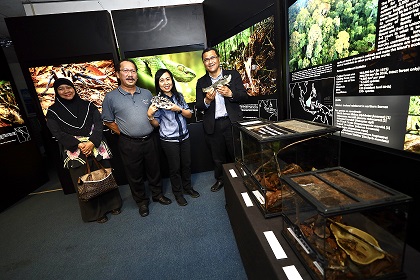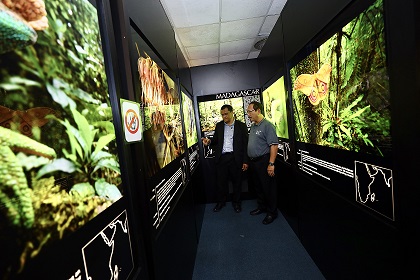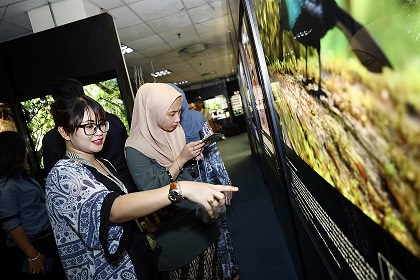Events Calendar



KOTA SAMARAHAN, 3rd October 2019: The World Animal Day 2019 and the Open Day of the Institute of Biodiversity and Environmental Conservation (IBEC) was held today at the Kota Samarahan campus of Universiti Malaysia Sarawak (UNIMAS). This year’s theme is ‘Discovering Biodiversity Through Photography’, the event extending to 4th October 2019.
The Institute’s Open Day commenced with an introduction by Prof Gabriel Tonga Noweg, Director of IBEC, followed by a welcoming speech by YBhg Prof Dr Wan Hashim Wan Ibrahim Deputy Vice Chancellor (Research and Innovation), who mentioned that the World Animal Day is celebrated in dozens of countries worldwide, to draw public attention to the world’s rich biological diversity.
The highlights of the programme included talks, a workshop and exhibition highlighting the role of wildlife photography in creating public awareness and film screening on the Institute’s outreach programmes as well as station-based biodiversity activities, with prizes.
Deputy Vice Chancellor, YBhg Prof Dr Wan Hashim Wan Ibrahim released the book “Conserving the Gems of Upper Baleh, Kapit, Sarawak”, a richly-illustrated work on the biological diversity of the said area, encountered by an expedition by the Institute and its partners from the Faculty of Resource Science and Technology, UNIMAS, the Sarawak Forest Department and World Wide Fund for Nature Malaysia. The Expedition, undertaken under the auspices of the Heart of Borneo Initiative, was supported by a grant from Sarawak Energy Berhad.
Talks today included ‘Photography for Taxonomic Studies’ by Dr. Jongkar Grinang, a decapod crustacean specialist with the Institute, followed by ‘Macrophotography’ by Pui Yong Min, graduate student and terrestrial ecologist with Sarawak Energy Berhad.
Several exciting displays were on offer such as photographic exhibition, entitled “Rainforests of the World”, highlighting the work of Chien C. Lee, photographer extraordinaire and an Honorary Research Associate of the Institute.
Films on the Institute’s outreach programmes targetting local communities at Kampung Jagoi, as well as the International Bornean Frog Race, were also screened. Visitors were also able to see a collection of live amphibians and reptiles, that serve as research subjects by the Institute’s students and staff, under permit from the Sarawak Forest Department. These researches were also described through a series of infographic posters, showing the diversity of work done by the Institute, from environment and plants to lizards, snakes, birds and mammals. A mini herbal garden rounded off the exhibition, showing the wealth of plant resources of Sarawak, of use to her people.
Additional activities included station-based biodiversity-related activities (with prizes), which included ‘spot animals in pictures’, crosswords puzzles, common herb identification, radio- telemetry and photo-identification of dolphins.
Finally, there was an exhibition and sale of nature-related products (including books) by IBEC partners, including the Sarawak Biodiversity Centre, Centre for Academic Information Services (CAIS) and UNIMAS Publisher.
The event continues on tomorrow with a talk session, ‘Wildlife in camera trapping’ by Associate Professor Dr Mohd Azlan Jayasilan bin Abdul Gulam Azad, staff and a workshop on drone photography by Anthony Pine, graduate student, and interactive activities related to biodiversity.
The World Animal Day and the Open Day of the Institute of Biodiversity and Environmental Conservation is open to the members of the public, who are also invited to visit the exhibitions and take part in other activities on offer, between 9:30am and 4:00pm.
The Institute of Biodiversity and Environmental Conservation, Universiti Malaysia Sarawak, through its research and advocacy attempts to draw public attention to the State’s rich biodiversity and the need to protect its forests and other natural resources.

